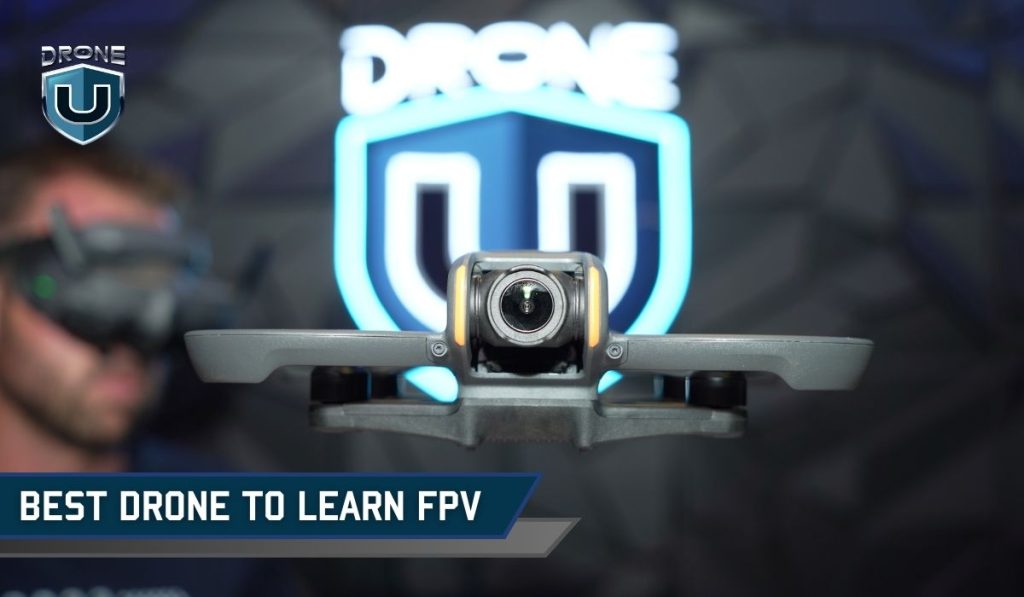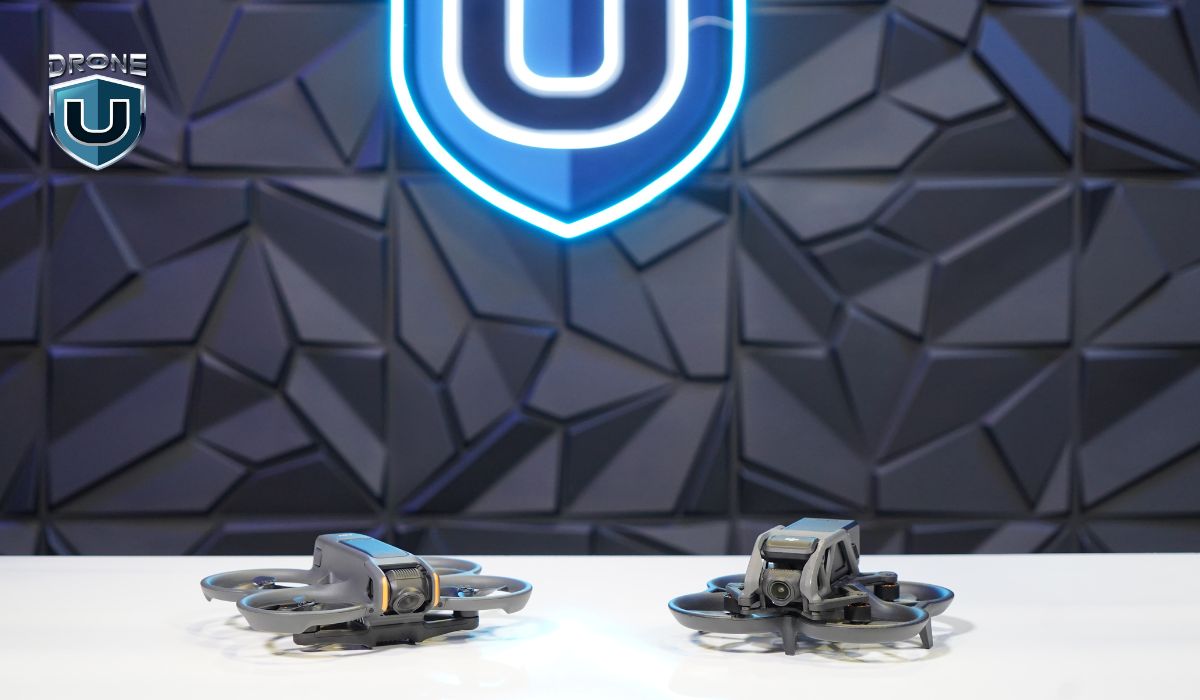
The world of drone flying has seen rapid advancements, with FPV (First-Person View) drones becoming increasingly popular among enthusiasts.
FPV flying offers an immersive experience, allowing pilots to feel as though they’re sitting in the cockpit of the drone, racing through the skies.
However, for beginners, the transition from traditional drone flying to FPV can be daunting. The key to a successful and enjoyable learning experience lies in choosing the right drone.
The DJI Avata 2 emerges as the best option for anyone looking to start their FPV journey, offering a perfect blend of ease, control, and innovative features.
In this article, we’ll explore why the DJI Avata 2 is considered the best drone for learning FPV. We’ll also cover important considerations for aspiring FPV pilots, including safety, and necessary equipment.
Let me break it down for you and explain why this bird is the ultimate choice for FPV newbies.
What is FPV?
FPV, or First-Person View, is a type of drone flying where the pilot controls the drone from a perspective that feels like they are on board the drone itself. This is achieved through a camera mounted on the drone that transmits live video to a headset worn by the pilot.
FPV drone flying differs significantly from traditional drone piloting:
1. Immersive Experience: Pilots see real-time video feed from the drone’s perspective.
2. Manual Control: FPV typically requires more hands-on control than automated consumer drones.
3. Skill Intensive: Mastering FPV flying often involves a steeper learning curve.
4. Versatility: FPV is popular in racing, freestyle flying, and cinematography.
Learning to fly an FPV drone is a challenging task. Unlike traditional drones with automated features like altitude hold and GPS stability, FPV drones require manual control, making them less forgiving for novices.
So What’s the Choice?
The answer is DJI Avata 2.
DJI Avata 2 – Best Drone to Learn FPV
DJI Avata 2 gives you the same user experience as a regular consumer drone. It’s like the perfect bridge between your typical drone and the wild world of FPV.
If you’ve been flying those regular consumer drones, the ones where you let go of the sticks and they just hover in place like magic? Well, the DJI Avata 2 gives you that same user experience. It’s like the perfect bridge between your typical drone and the wild world of FPV.
One of the standout features of the DJI Avata 2 is its ability to offer a seamless transition from traditional drone flying to FPV. When you’re used to flying consumer drones, your remote has two sticks that center themselves when you let go. It’s all nice and predictable. But with FPV, you’re the one in control of that altitude, baby. And that’s where the Avata 2 shines.
This familiarity makes it much easier for beginners to start exploring FPV without feeling overwhelmed.
Key Features That Make the DJI Avata 2 Ideal for FPV Beginners

1. Stability and Ease of Use
The DJI Avata 2 is designed with stability in mind, offering a flight experience that is similar to what most traditional drone users are accustomed to. When you release the control sticks, the drone will stop in place and hold its altitude, a feature that is incredibly useful for beginners. This stability allows new pilots to focus on learning the basics of FPV flying without worrying about losing control of the drone.
2. Manual/Acro Mode
One of the most exciting features of the DJI Avata 2 is its manual mode, also known as Acro mode. This mode allows you to take full control of the drone’s movements, including its altitude. For beginners, this might sound intimidating, but the DJI Avata 2 makes it easier by allowing you to switch between different flight modes. You can start with the more forgiving normal or sports modes and gradually transition into manual mode as your skills improve. This flexibility is crucial for learning FPV flying at your own pace.
3. Customizable Remote
The remote control of the DJI Avata 2 is another feature that sets it apart from other drones. The back panel of the remote can be removed, allowing you to adjust the spring tension in the control sticks. This customization is particularly useful when flying in manual mode, as it allows you to keep the altitude at a more precise position. With the right adjustments, you can fine-tune the remote to suit your flying style, making the learning process more intuitive and less frustrating.
4. Battery Life and Consistency
Battery life is a critical factor for any drone, and the DJI Avata 2 does not disappoint. The standard manufacturer-based batteries provide a consistent flight time, typically around 18 to 20 minutes. This consistency is vital for beginners who are still learning to manage their flight time and battery usage.
Why the DJI Avata 2 Stands Out
So, why is the DJI Avata 2 the absolute best drone to learn FPV? Let’s summarize:
- Smooth Transition: It bridges the gap between traditional drones and FPV flying seamlessly.
- Versatile Flight Modes: From beginner-friendly to pro-level manual control, all in one package.
- Customizable Remote: The modifiable stick tensions give you precise control when you need it most.
- Consistent Performance: Standard batteries mean predictable flight times and performance, crucial for learning.
- Growth Potential: It’s a drone that grows with you, from beginner to expert.
- Therapeutic Experience: There’s a joy to flying this drone that goes beyond just piloting.
- Cinematic Capabilities: Once mastered, it can capture professional-grade footage.
Potential Drawbacks of the DJI Avata 2
While the DJI Avata 2 excels in many areas, it’s important to consider some potential drawbacks:
- Cost: It’s more expensive than many entry-level FPV drones, which might be a barrier for some beginners.
- Size and Weight: Heavier than typical FPV drones, it may feel less agile for experienced pilots.
- Repairability: DJI products can be more challenging to repair yourself compared to some open-source alternatives.
- Ecosystem Lock-in: You’re largely confined to DJI’s ecosystem of products and software.
Safety Considerations for New FPV Pilots
Safety should be a top priority for all drone pilots, especially those new to FPV flying:
1. Know the laws: Familiarize yourself with local drone regulations and obtain the necessary certifications.
2. Start slow: Practice in open areas away from people, animals, and obstacles.
3. Use a simulator: FPV simulators can help you gain skills without risking your drone.
4. Wear proper equipment: Always use FPV goggles designed for drone use.
5. Maintain line of sight: Have a spotter to keep an eye on your drone when you’re wearing FPV goggles.
6. Check your equipment: Always inspect your drone and controllers before flying.
7. Be aware of your surroundings: Watch for changes in weather, other aircraft, and potential hazards.
Additional Equipment Needed
To get started with the DJI Avata 2, you’ll need more than just the drone:
1. FPV Goggles: DJI Goggles 2 or DJI FPV Goggles V2 are compatible options.
2. Controller: DJI FPV Remote Controller 2 or DJI Motion Controller.
3. Extra batteries: For extended flying sessions.
4. Propeller guards: Recommended for beginners to protect the drone during crashes.
5. Micro SD card: For recording high-quality footage.
6. Carrying case: To safely transport your drone and accessories.
7. Simulator software: For risk-free practice (optional but recommended).
Final Thoughts
The DJI Avata 2 stands out as an excellent choice for those looking to enter the world of FPV drone flying.
Its blend of user-friendly features, stability, and advanced capabilities make it a versatile option that can grow with you as your skills improve. However, it’s important to consider your budget, goals, and the commitment required to master FPV flying.
If you’re serious about getting into FPV flying, the DJI Avata 2 is hands down the best place to start. It’s got everything you need to learn, grow, and eventually master the art of FPV drone piloting.
Whether you choose the Avata 2 or another beginner-friendly FPV drone, remember that patience, practice, and safety are key to your success.
With time and dedication, you’ll be experiencing the thrill of FPV flight and capturing breathtaking aerial footage.
The sky’s the limit in your FPV journey!








Add Your Comment